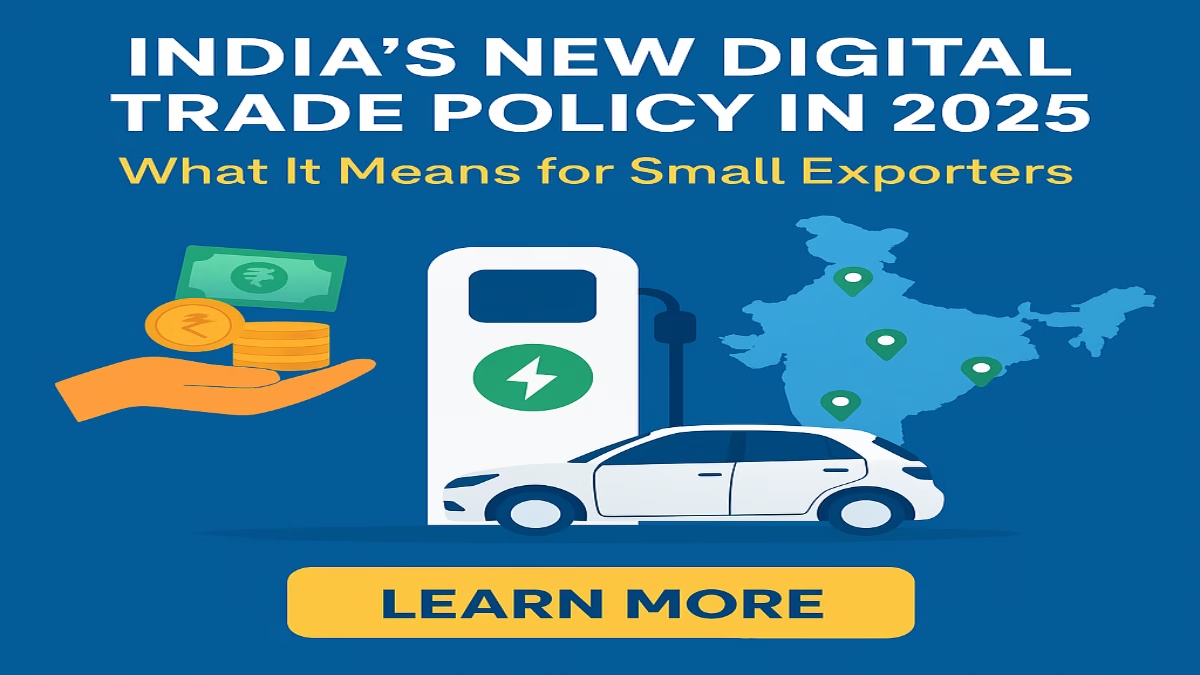Introduction
In a rapidly globalizing world, small businesses are no longer limited by borders. Technology has given even the smallest Indian exporter the chance to compete internationally. But with opportunity comes challenges—compliance, digital regulations, and market access barriers. This is where India’s New Digital Trade Policy in 2025 steps in.
Announced as part of India’s broader trade reforms, this policy aims to simplify cross-border digital commerce, empower micro, small, and medium enterprises (MSMEs), and position India as a leader in the global digital economy. For small exporters, it’s not just another policy—it could be a game-changer.
In this article, we’ll break down what India’s New Digital Trade Policy in 2025 is, how it affects exporters, and what benefits and challenges you should know before planning your global journey.
Why India Needed a Digital Trade Policy
For years, Indian exporters faced multiple barriers when selling overseas:
- Complex compliance with foreign data laws.
- Payment delays due to lack of trusted digital payment systems.
- High logistics costs for small shipments.
- No clear framework for e-commerce taxation.
The government realized that without a forward-looking digital trade strategy, India’s MSMEs would be left behind. That’s why India’s New Digital Trade Policy in 2025 was created—to bridge the gap between digital opportunity and business reality.
Key Features of India’s New Digital Trade Policy in 2025
Let’s break down the most important features of this landmark policy and why they matter to exporters.
1. Simplified Digital Documentation
The policy introduces a one-stop digital trade portal where exporters can upload, verify, and track trade documents. This reduces paperwork and speeds up customs clearances.
2. Cross-Border Data Flows
One of the biggest highlights of India’s New Digital Trade Policy in 2025 is that it allows regulated cross-border data flows. This means exporters using digital platforms like Amazon, Shopify, or Flipkart Global will find it easier to manage customer data without violating international privacy laws.
3. Digital Payment Integration
The policy integrates UPI-based cross-border payments, reducing dependence on expensive forex channels. Exporters can now receive payments faster, with lower transaction fees.
4. Support for Small Exporters
To encourage participation, the policy provides financial incentives for exporters adopting digital tools, including:
- Subsidies for e-commerce training programs.
- Tax breaks for digital trade platform memberships.
- Insurance coverage for cyber risks in international trade.
5. E-Commerce Logistics Support
The government will partner with logistics companies to provide affordable cross-border delivery solutions, enabling small exporters to ship low-volume orders competitively.
How Global Oil Prices in 2025 Could Change India’s Fuel Subsidies
How Small Exporters Benefit
The real question is—what does India’s New Digital Trade Policy in 2025 mean for you as a small exporter?
Easier Market Access
You no longer need big budgets or complex infrastructure to enter international markets. Digital platforms combined with the policy’s support make global reach more accessible.
Lower Costs
From cheaper payment gateways to subsidized logistics, exporters will save significantly on operational expenses.
Faster Growth
By reducing compliance hurdles and enabling easier digital trade, small exporters can scale faster, even in highly competitive sectors like handicrafts, apparel, food products, or digital services.
Challenges and Risks
While India’s New Digital Trade Policy in 2025 opens many doors, exporters should also be aware of potential challenges:
- Cybersecurity Threats – More digital trade means higher risks of cyber fraud.
- Learning Curve – Many small exporters may need training to use digital platforms effectively.
- Global Competition – With easier access, competition from other developing countries will intensify.
Real-World Example: A Handloom Exporter in Varanasi
Imagine Ritu, a handloom business owner from Varanasi. Previously, she relied on middlemen to sell her products abroad, often losing profit margins. Under India’s New Digital Trade Policy in 2025, Ritu registers on the trade portal, lists her products on an international marketplace, receives payments directly through UPI, and ships small orders using subsidized logistics.
Within a year, her exports triple. What was once a local business is now global—all thanks to the new digital framework.
Global Alignment and India’s Strategy
India’s New Digital Trade Policy in 2025 isn’t just about helping exporters—it’s about positioning India as a global digital trade hub.
- WTO Alignment – India’s policy is in sync with World Trade Organization rules on e-commerce.
- Bilateral Agreements – India is negotiating digital trade pacts with the EU, the US, and ASEAN nations.
- Data Sovereignty – While enabling cross-border trade, India ensures local data storage for security.
What Small Exporters Should Do Now
To take advantage of India’s New Digital Trade Policy in 2025, here’s what exporters should do immediately:
- Register on the Digital Trade Portal – Ensure your business is compliant.
- Adopt E-Commerce Platforms – Start selling on international marketplaces.
- Integrate Digital Payments – Use UPI-based cross-border solutions for smooth transactions.
- Train Your Team – Invest in digital skills to manage global trade better.
- Secure Your Business – Get cyber insurance and adopt secure digital practices.
Future of Digital Trade in India
By 2030, experts predict India’s digital exports could cross $350 billion, with MSMEs contributing a significant share. Policies like India’s New Digital Trade Policy in 2025 will be the backbone of this growth, transforming India into a digital-first export powerhouse.
FOLLOW TIME OF HINDUSTAN ON FACEBOOK
Conclusion
For years, small exporters struggled with paperwork, delayed payments, and lack of access to global markets. Now, with India’s New Digital Trade Policy in 2025, the government is leveling the playing field.
This policy doesn’t just simplify digital trade—it empowers small exporters to dream bigger, go global, and compete with established international players. Whether you’re a handicraft seller, an IT services provider, or a food exporter, this is your moment to seize the opportunity.
India has taken a bold step, and now it’s up to entrepreneurs to make the most of it.

